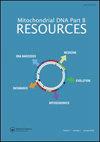苦苣苔科苦苣苔和苦苣苔叶绿体全基因组。
IF 0.5
4区 生物学
Q4 GENETICS & HEREDITY
Mitochondrial DNA. Part B, Resources
Pub Date : 2025-03-27
eCollection Date: 2025-01-01
DOI:10.1080/23802359.2025.2482254
引用次数: 0
摘要
石花属是喀斯特地区特有的植物,具有较高的花形态多样性。我们组装并鉴定了Petrocodon mirus的全叶绿体基因组,石旭志,傅建新和杨丽辉2024和Petrocodon hancei (Hemsl. 1890) a.w oberber & Mich。穆勒2011。基因组大小分别为153,547 bp和153,294 bp。系统发育分析表明,汉花假单胞与多花假单胞亲缘关系较近,而假单胞的位置尚不清楚。这些发现为研究石斛科和苦苣苔科植物的遗传多样性提供了基因组资源。本文章由计算机程序翻译,如有差异,请以英文原文为准。
The complete chloroplast genomes of Petrocodon mirus and Petrocodon hancei (Gesneriaceae).
The genus Petrocodon is uniquely distributed in karst areas and exhibits high floral morphological diversity. We assembled and characterized the complete chloroplast genomes of Petrocodon mirus X.Z.Shi, J.X.Fu & L.H.Yang 2024 and Petrocodon hancei (Hemsl. 1890) A.Weber & Mich.Möller 2011. The genome sizes are 153,547 bp and 153,294 bp, respectively. Phylogenetic analysis revealed that P. hancei is closely related to P. multiflorus, while the position of P. mirus remains unclear. These findings provide genomic resources for studying genetic diversity in Petrocodon and Gesneriaceae.
求助全文
通过发布文献求助,成功后即可免费获取论文全文。
去求助
来源期刊

Mitochondrial DNA. Part B, Resources
Biochemistry, Genetics and Molecular Biology-Molecular Biology
CiteScore
1.30
自引率
20.00%
发文量
670
期刊介绍:
This open access journal publishes high-quality and concise research articles reporting the sequence of full mitochondrial genomes, and short communications focusing on the physical, chemical, and biochemical aspects of mtDNA and proteins involved in mtDNA metabolism and interactions.
 求助内容:
求助内容: 应助结果提醒方式:
应助结果提醒方式:


